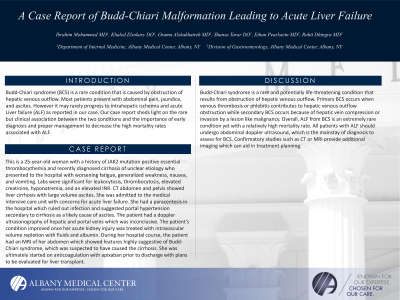Sunday Poster Session
Category: Liver
P1315 - A Case Report of Budd-Chiari Malformation Leading to Acute Liver Failure
Sunday, October 27, 2024
3:30 PM - 7:00 PM ET
Location: Exhibit Hall E

Has Audio
- IM
Ibrahim Mohammed, MD
Albany Medical Center
Albany, NY
Presenting Author(s)
Ibrahim Mohammed, MD1, Khaled Elsokary, DO1, Osama Alshakhatreh, MD1, Shunsa Tarar, DO1, Ethan Pearlstein, MD1, Rohit Dhingra, MD2
1Albany Medical Center, Albany, NY; 2Albany Gastroenterology Consultants, Albany, NY
Introduction:
Budd-Chiari syndrome (BCS) is a rare condition that is caused by obstruction of hepatic venous outflow. Most patients present with abdominal pain, jaundice, and ascites. However it may rarely progress to intrahepatic ischemia and acute Liver failure (ALF) as reported in our case. Our case report sheds light on the rare but clinical association between the two conditions and the importance of early diagnosis and proper management to decrease the high mortality rates associated with ALF.
Case Description/Methods:
This is a 25-year-old woman with a history of JAK2 mutation positive essential thrombocythemia and recently diagnosed cirrhosis of unclear etiology who presented to the hospital with worsening fatigue, generalized weakness, nausea, and vomiting. Labs were significant for leukocytosis, thrombocytosis, elevated creatinine, hyponatremia, and an elevated INR. CT abdomen and pelvis showed liver cirrhosis with large volume ascites. She was admitted to the medical intensive care unit with concerns for acute liver failure. She had a paracentesis in the hospital which ruled out infection and suggested portal hypertension secondary to cirrhosis as a likely cause of ascites. The patient had a doppler ultrasonography of hepatic and portal veins which was inconclusive. The patient's condition improved once her acute kidney injury was treated with intravascular volume repletion with fluids and albumin. During her hospital course, the patient had an MRI of her abdomen which showed features highly suggestive of Budd-Chiari syndrome, which was suspected to have caused the cirrhosis. She was ultimately started on anticoagulation with apixaban prior to discharge with plans to be evaluated for liver transplant.
Discussion:
Budd-Chiari syndrome is a rare and potentially life-threatening condition that results from obstruction of hepatic venous outflow. Primary BCS occurs when venous thrombosis or phlebitis contributes to hepatic venous outflow obstruction while secondary BCS occurs because of hepatic vein compression or invasion by a lesion like malignancy. Overall, ALF from BCS is an extremely rare condition yet with a relatively high mortality rate. All patients with ALF should undergo abdominal doppler ultrasound, which is the mainstay of diagnosis to assess for BCS. Confirmatory studies such as CT or MRI provide additional imaging which can aid in treatment planning.
Disclosures:
Ibrahim Mohammed, MD1, Khaled Elsokary, DO1, Osama Alshakhatreh, MD1, Shunsa Tarar, DO1, Ethan Pearlstein, MD1, Rohit Dhingra, MD2. P1315 - A Case Report of Budd-Chiari Malformation Leading to Acute Liver Failure, ACG 2024 Annual Scientific Meeting Abstracts. Philadelphia, PA: American College of Gastroenterology.
1Albany Medical Center, Albany, NY; 2Albany Gastroenterology Consultants, Albany, NY
Introduction:
Budd-Chiari syndrome (BCS) is a rare condition that is caused by obstruction of hepatic venous outflow. Most patients present with abdominal pain, jaundice, and ascites. However it may rarely progress to intrahepatic ischemia and acute Liver failure (ALF) as reported in our case. Our case report sheds light on the rare but clinical association between the two conditions and the importance of early diagnosis and proper management to decrease the high mortality rates associated with ALF.
Case Description/Methods:
This is a 25-year-old woman with a history of JAK2 mutation positive essential thrombocythemia and recently diagnosed cirrhosis of unclear etiology who presented to the hospital with worsening fatigue, generalized weakness, nausea, and vomiting. Labs were significant for leukocytosis, thrombocytosis, elevated creatinine, hyponatremia, and an elevated INR. CT abdomen and pelvis showed liver cirrhosis with large volume ascites. She was admitted to the medical intensive care unit with concerns for acute liver failure. She had a paracentesis in the hospital which ruled out infection and suggested portal hypertension secondary to cirrhosis as a likely cause of ascites. The patient had a doppler ultrasonography of hepatic and portal veins which was inconclusive. The patient's condition improved once her acute kidney injury was treated with intravascular volume repletion with fluids and albumin. During her hospital course, the patient had an MRI of her abdomen which showed features highly suggestive of Budd-Chiari syndrome, which was suspected to have caused the cirrhosis. She was ultimately started on anticoagulation with apixaban prior to discharge with plans to be evaluated for liver transplant.
Discussion:
Budd-Chiari syndrome is a rare and potentially life-threatening condition that results from obstruction of hepatic venous outflow. Primary BCS occurs when venous thrombosis or phlebitis contributes to hepatic venous outflow obstruction while secondary BCS occurs because of hepatic vein compression or invasion by a lesion like malignancy. Overall, ALF from BCS is an extremely rare condition yet with a relatively high mortality rate. All patients with ALF should undergo abdominal doppler ultrasound, which is the mainstay of diagnosis to assess for BCS. Confirmatory studies such as CT or MRI provide additional imaging which can aid in treatment planning.
Disclosures:
Ibrahim Mohammed indicated no relevant financial relationships.
Khaled Elsokary indicated no relevant financial relationships.
Osama Alshakhatreh indicated no relevant financial relationships.
Shunsa Tarar indicated no relevant financial relationships.
Ethan Pearlstein indicated no relevant financial relationships.
Rohit Dhingra indicated no relevant financial relationships.
Ibrahim Mohammed, MD1, Khaled Elsokary, DO1, Osama Alshakhatreh, MD1, Shunsa Tarar, DO1, Ethan Pearlstein, MD1, Rohit Dhingra, MD2. P1315 - A Case Report of Budd-Chiari Malformation Leading to Acute Liver Failure, ACG 2024 Annual Scientific Meeting Abstracts. Philadelphia, PA: American College of Gastroenterology.
